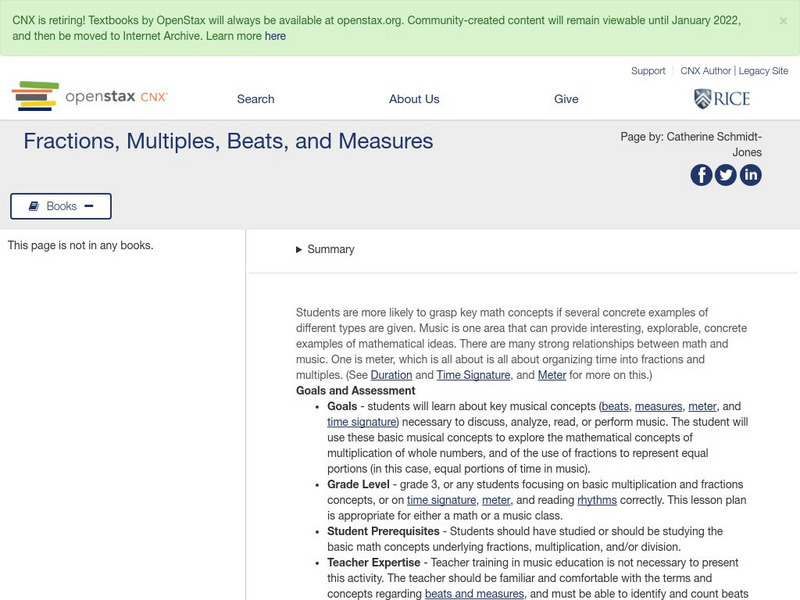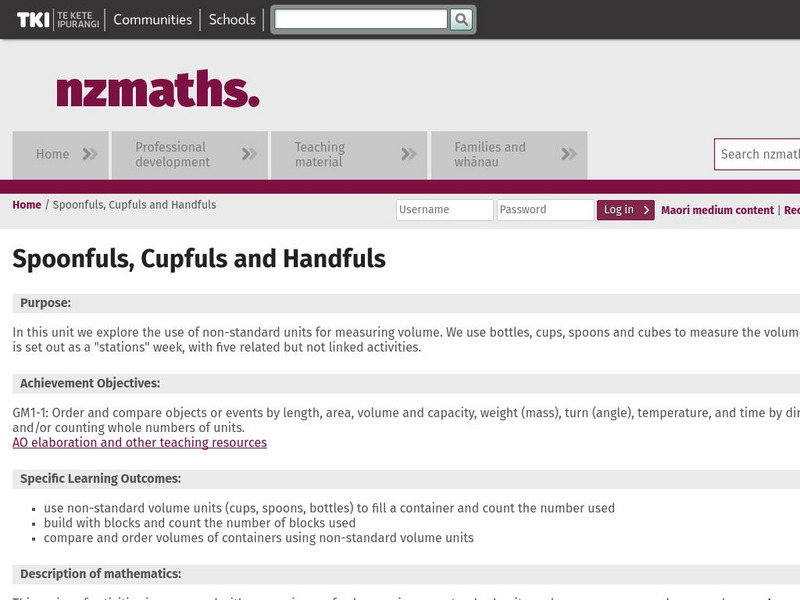Hi, what do you want to do?
Alabama Learning Exchange
Alex: Hop on Pop and Non Standard Measurement
This instructional activity is a hands-on, cross-curricular instructional activity for exploring non-standard measurement. It utilizes children's literature, manipulatives, opportunities for writing, and small group collaborative...
Alabama Learning Exchange
Alex: Why Do We Need Measurement Tools?
This lesson will explore the need for standard measurement tools. It will engage the students and promote critical thinking and reasoning. This is a lead in lesson to conversions. This lesson plan was created by exemplary Alabama Math...
OpenStax
Open Stax: Catherine Schmidt Jones: Fractions, Multiples, Beats, and Measures
Engage your students in a lesson that uses music to identify multiples and fractions. Your students will enjoy participating in this activity as they learn and explore music and math.
Alabama Learning Exchange
Alex: The Horizons of Soil in My Backyard
Students will work in small groups to dig holes 1 meter deep. Students will work with measurements as they dig and measure. Students will observe the different types of soil and how the soil changes as they dig. Students will write and...
Discovery Education
Discovery Education: Stories From Africa
At the end of this lesson, students will have a better understanding of the size of the African elephant. This could be used in an animal science unit, a measuring unit in math, an extension to literature, or for social studies...
Other
Nz Maths Measurement Lesson Plan: Spoonfuls, Cupfuls, and Handfuls
This New Zealand Measurement lesson plan offers an excellent opportunity for young students to explore, in a hands-on context, the concept of volume using non-standard units. There is also a Home Link available to send home for parents...
Alabama Learning Exchange
Alex: What Is an Inch?
This activity gives the students the opportunity to see what an inch really looks like. It also provides them with a chance to be creative using various inch materials and to create a visual for what an inch is. It is a great lesson to...
PBS
Pbs Learning Media: Pbs Kids Afterschool Adventure!
These five-day thematic, multimedia activity plans designed for afterschool programs can be implemented in just about 20 minutes each day. Practice and build math skills with PBS Kids Lab daily or weekly.
Alabama Learning Exchange
Alex: Souper Scooper
This hands-on, inquiry based lesson is an extension of the AMSTI Science Module, Solids and Liquids. Young scholars use nonstandard units to measure beans in a soup mix. Students predict how many beans will be in a scoop. Young scholars...
Alabama Learning Exchange
Alex: Inch by Inch Learning Is a Cinch
This lesson uses an interdisciplinary approach involving literature, math, and writing. Using the book, Inch by Inch, by Leo Lionni students will explore the world of measurement. They will have the opportunity to practice measuring...
Alabama Learning Exchange
Alex: Wheels All Around
Students will use skip counting to see how many wheels visit the school during specified times in one day. This lesson plan was created as a result of the Girls Engaged in Math and Science University, GEMS-U Project.
Curated OER
Fill It Up
An excellent compilation of activities that engage parents and children in math explorations at home. Detailed lessons covering a wide range of math topics such as fractions, measurements, money, data collection, and math in newspapers....
Curated OER
Money's Worth
An excellent compilation of activities that engage parents and children in math explorations at home. Detailed lessons covering a wide range of math topics such as fractions, measurements, money, data collection, and math in newspapers....
Curated OER
Simply Symmetrical
An excellent compilation of activities that engage parents and children in math explorations at home. Detailed lessons covering a wide range of math topics such as fractions, measurements, money, data collection, and math in newspapers....
Curated OER
Newspaper Search
An excellent compilation of activities that engage parents and children in math explorations at home. Detailed lessons covering a wide range of math topics such as fractions, measurements, money, data collection, and math in newspapers....
Curated OER
Fill It Up
An excellent compilation of activities that engage parents and children in math explorations at home. Detailed lessons covering a wide range of math topics such as fractions, measurements, money, data collection, and math in newspapers....
Curated OER
Fractured Fractions
An excellent compilation of activities that engage parents and children in math explorations at home. Detailed lessons covering a wide range of math topics such as fractions, measurements, money, data collection, and math in newspapers....
Curated OER
Money's Worth
An excellent compilation of activities that engage parents and children in math explorations at home. Detailed lessons covering a wide range of math topics such as fractions, measurements, money, data collection, and math in newspapers....
Curated OER
Tracking Time
An excellent compilation of activities that engage parents and children in math explorations at home. Detailed lessons covering a wide range of math topics such as fractions, measurements, money, data collection, and math in newspapers....














